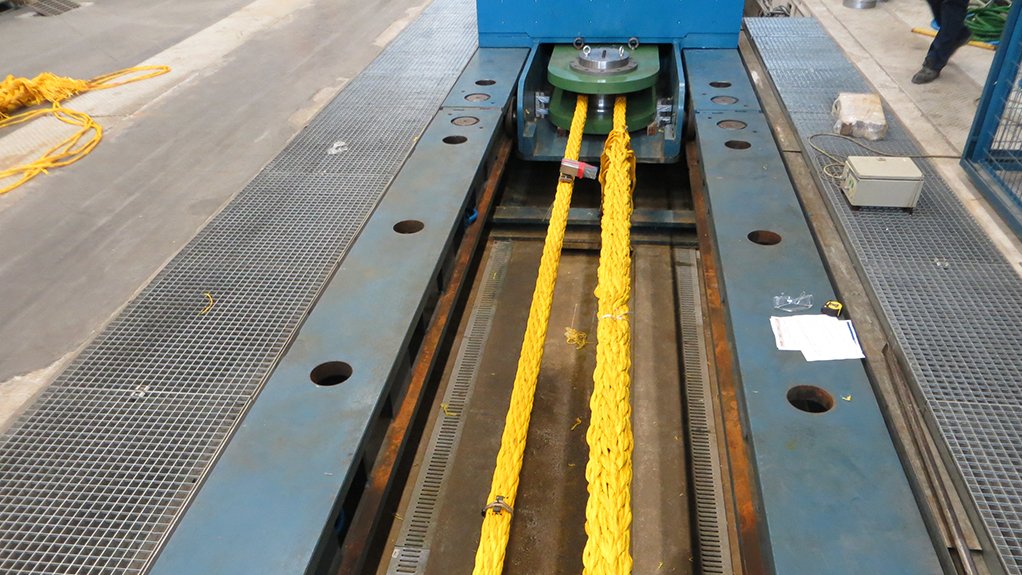Leading supplier of maritime ropes and heavy lift slings Lankhorst Ropes is the first fibre rope manufacturer to achieve DNVGL Approval of Manufacture (AoM) for its LankoForce heavy lift slings.
Achieving DNVGL-CP-0173 AoM certification shows that Lankhorst’s sling production process has been reviewed and evaluated, and it is now shown that it complies with the strict requirements for E303 certification.
DNVGL-CP-0173 Offshore Fibre Ropes certification is an important steppingstone in the wider market acceptance of heavy lift, fibre rope slings.
According to Lankhorst Ropes sales manager Marcel van der Molen there is no specific standard for synthetic heavy lifting slings, “which is why we are working in close collaboration with certification body DNV-GL to qualify our slings according the ‘Qualification of New Technology’ (DNV-RP-A203) and DNVGL-OS-E303 Offshore Fibre Ropes certification”.
Certifications cover the technical requirements of offshore fibre ropes and offshore fibre tethers.
Further, in recent years, oil and gas and offshore energy industries have shown an increasing interest in the use of synthetic fibre rope slings, especially in offshore engineered lifting operations.
Synthetic fibre rope slings offer many advantages compared to steel wire rope slings which translate into significant operational savings.
However, widespread adoption of synthetic fibre rope slings has been hindered mainly by the lack of understanding of fibre rope characteristics and discard criteria; and because no relevant fibre rope standards exist for engineered lifting operations.
Meanwhile, in parallel with its collaboration with DNVGL and the importance of sling certification, Lankhorst has an ongoing research and development (R&D) programme into the characteristics and performance of fibre rope slings.
The R&D programme is a joint effort with installation companies and includes accurate lifting simulations based on real lift operations input, thereby developing full understanding of rope performance under relevant usage scenarios.
Typically, fibre slings are designed for engineered lifts. These are project-specific, non-routine lifts and specially prepared and documented by industry procedures such as DNV-RP-H201.
The factors governing the design of the slings include the load capacity of the rope; load elongation characteristics, including stand and dynamic stiffness; and sling construction: eye and eye or endless (grommet), working length and environmental requirements.
Lankhorst manufactures the Lankoforce range of heavy lift slings with a minimum breaking load of around 2 000 t in single leg configuration and 3 200 t in an endless configuration.
Van der Molen notes that the Lankhorst approach is to look at the complete lifting system, recognising that the slings are part of a complex system where interfaces need to be understood and managed.
“From this Lankhorst aims to under- stand the rope’s service life in terms of operational limits covering the use of the rope and failure modes such as fatigue, abrasion, creep and mechanical damage, for example.”
He adds that the company is building the knowledge needed to understand the service context and lifting scenarios and through this develop interfaces and understand failure modes and boundary conditions.
Based on this Lankhorst is developing relevant testing procedures and testing under realistic load conditions, and the ability to certify and recertify ropes.”
Fundamental to Lankhorst’s research is certification. Product certification means that the full production process, comprising manufacture, testing, assembly and commissioning, has been reviewed and validated by an independent body, and complies with industry best practices and/or standards.
A certificated rope sling is important in ensuring greater reliability, durability and extended service life which, in turn, translates into reduced sling maintenance costs, repairs and replacement.
When fibre rope slings are certified according to the requirements of DNVGL-OS-E303, it indicates that they are properly engineered, tested and manufactured. In addition, they meet the highest industry quality levels, and are designed to provide the highest performance and reliability, while fulfilling the intended application requirements.
“Buying and using a product that is not certified, although a lower initial investment, will increase the inherent risks of failure, repairs and other “surprises.”
He also stresses that a Verification Statement for a proof-load test is not a certificate.
A proof-load test will provide evidence that a sling has experienced a particular static load, for a certain amount of time, under laboratory and controlled conditions.
This kind of load capacity verification does not consider any other characteristic loads experienced during a real lifting operation – for example dynamic loadings – and, therefore, it is a poor indication of sling performance and reliability in a project scenario.
With AoM certification, Lankoforce heavy lifting slings has reached another milestone to achieving certification readiness status, according to DNVGL-OS-E303, which can be readily incorporated into a fully integrated heavy lift systems development, if required, concludes Van der Molen.
Edited by: Zandile Mavuso
Creamer Media Senior Deputy Editor: Features
EMAIL THIS ARTICLE SAVE THIS ARTICLE
ARTICLE ENQUIRY
To subscribe email subscriptions@creamermedia.co.za or click here
To advertise email advertising@creamermedia.co.za or click here













